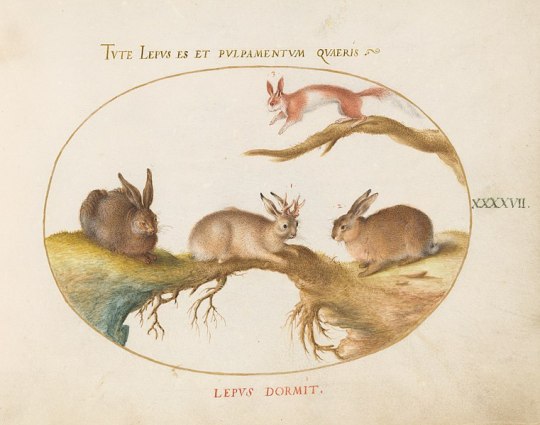#please support faux taxidermy made from synthetic materials so no more little animals need be harmed in this trade : )
Text
The Creature Awaits #123:
Each week I plan to feature an amazing creature, admiring God's fantastic artistry. Hopefully it’ll brighten someone’s day to see something new and interesting if they haven’t seen it before. : )

(Photographs taken by B.G. Washburn and The Mountain-Prairie Region of the U.S. Fish and Wildlife Service (Both: CC BY 2.0))
The Jackalope
Scientific Name: Lepus antilocapra
Region: Western North America
Size: About 24"-30" (~61cm-76cm) long
Seriously.......?: As a kid who grew up in the Western U.S, my husband asked me to feature the Jackalope for his birthday this year.
The Jackalope is a "fearsome critter" whose name was coined in early 20th century United States folklore. While their origin is generally credited to hunter-taxidermists Ralph and Doug Herrick, who first grafted a pronghorn's antlers onto a dead jackrabbit in order to boost sales in their ethically dubious trade, the Jackalope's actual source may be much more grounded in history than originally perceived.
The Shope papilloma virus, discovered in the 1930s by U.S. virologist Richard Shopes, causes keratinized tumors, shaped much like horns or antlers, to protrude through the rabbit's skin - often on the head and face. As featured by the Smithsonian Institute and elsewhere, modern researchers believe this virus may be the reason behind some of the old legends of mysteriously horned, now-deemed mythological creatures, such as the "horned hare" pictured in Joris Hoefnagel's scientific illustration series from 1575, Animalia quadrupedia et reptilia (terra), pictured below.

(Sidenote: Please support faux taxidermy made from synthetic materials so no more little animals need be harmed in this trade. : ) )
#creatureawaits#jackalope#jackrabbit#pronghorn#horned hare#fearsome critter#mythological creatures#made-up animals#legends#folklore#western folk tales#american folk tales#please support faux taxidermy made from synthetic materials so no more little animals need be harmed in this trade : )
9 notes
·
View notes